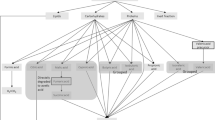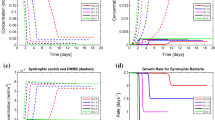Abstract
Synthetic waters imitating BOD5 test conditions have been studied to model the progress curves of cell growth, organic matter consumption and oxygen demand. Glucose and glutamic acid were used as organic matter and Bacillus subtilis, Escherichia coli and Pseudomonas putida as microorganisms. The concentrations of all the products were measured simultaneously over time and were fitted to the Logistic and Monod models. Following this, the goodness of fit was analysed. Discrimination between models allowed us to conclude that the Logistic model has acceptable accuracy to describe the kinetic behaviour inside a BOD5 bottle, while the extra parameter in the Monod model would not be statistically justified. Thus, the logistic parameters were determined under different conditions by non-linear regression and their biological meaning was interpreted.




Similar content being viewed by others
References
APHA-AWWA-WPCF (1998) Standard methods for the examination of water and wastewater, 19th edn. American Public Health Association. Part 5210. Washington
Phelps EB (1909) The disinfection of sewage and sewage filter effluents. US Geological Survey Water Supply 224
Streeter HW, Phelps EB (1925) A study of the pollution and natural purification of the Ohio River, III. Factors concerned in the phenomena of oxidation and reaeration. Public Health Service bulletin 146. Washington
Metcalf and Eddy (1977) Wastewater engineering, treatment, disposal and reuse. McGraw Hill, New York, pp 84–86
Cutrera G, Manfredi L, Valle CE, González JF (1999) On the determination of the kinetic parameters for the BOD test. Water SA 25(3):377–379
Adrian DD, Sanders TG (1992) Oxygen sag equations for half order BOD kinetics. J Environ Syst 22(4):341–351
Young JC, Clark JW (1965) Second order equation for BOD. J Sanitary Eng Div Am Soc Civ Eng 91(SA1):43–57
Adrian DD, Sanders TG (1998) Oxygen sag equation for second-order BOD decay. Wat Res 32(3):840–848
Adrian DD, Roider EM, Sanders TG (2004) Oxygen sag models for multiorder biochemical oxygen demand reactions. J Environ Eng 130(7):784–791
Mason IG, McLachlan RI, Gérad DT (2006) A double exponential model for biochemical oxygen demand. Bioresource Technol 97:273–282
Stones T (1981) A Résumé of the kinetics of the BOD test. Wat Pollut Control, pp 513–520
Mauyo Y (1990) An autocatalytic model for the kinetics of BOD test. Wat Res 24(9):1091–1095
Monod J (1949) The growth of bacterial cultures. Ann Rev Microbiol 3:371–394
Green M, Shelef G, Moraine R (1981). Chemical and biochemical oxygen demand as Indicators of biodegradable substrate concentration. Wat Pollut Control, pp 655–658
Vanrolleghem PA, Daele MV, Dochain D (1995) Practical identifiability of a biokinetic model of activated sludge respiration. Wat Res 29(11):2561–2570
Dochain D, Vanrolleghem PA, Daele MV (1995) Structural identifiability of biokinetic models of activated sludge respiration. Wat Res 29(11):2571–2578
Jeyaseelan S (1997) A simple mathematical model for anaerobic digestion process. Wat Sci Tech 35(8):185–191
Tsuneda S, Auresenia J, Takayuki M, Hirata A (2002) Dynamic modeling and simulation of a three-phase fluidized bed batch process for wastewater treatment. Process Biochem 38:599–604
Marsili-Libelli S (1986) Modelling batch BOD exertion curves. Environ Tech Lett 7:341–350
Gujer W, Henze M, Mino T, Loosdrech MCM (1999) Activated sludge model No. 3. Wat Sci Tech 39(1):183–193
Henze M, Gujer W, Mino T, Matsuo T, Wentzel MC, Marais GVR, Loosdrecht MCM (1999). Activated sludge model No. 2d, ASM2d. Wat Sci Tech 39(1): 165–182
Morgenroth E, Kommendal R, Harremöes P (2002) Processes and modelling of hydrolysis of particulate organic matter in aerobic wastewater treatment—a review. Wat Sci Tech 45(6):25–40
Trinder P (1969) Determination of glucose in blood using glucose oxidase with an alternative oxygen acceptor. Ann Clin Biochem 6:24–27
Moore S (1968) Aminoacid analysis: aqueous dimethyl sulfoxide as solvent for the ninhydrin reaction. J Biol Chem 243:6281–6283
Edelstein-Keshet L (1987) Mathematical models in biology. McGraw-Hill, New York, pp 115–126
Bardsley WG (2005). SIMFIT Statistical package, release 5.6.1. University of Manchester. http://www.simfit.man.ac.uk. Accessed 26 June 2005
Acknowledgments
We thank to Angel Dominguez and Ana Sánchez from the Microbiological Department at the University of Salamanca in Spain for donating the microorganisms strains and helping with cells manipulations.
Author information
Authors and Affiliations
Corresponding author
Rights and permissions
About this article
Cite this article
Martín, M.J., Burguillo, F.J. & Bardsley, W.G. Modelling the simultaneous processes occurring during the BOD5 test using synthetic waters as a pattern. Bioprocess Biosyst Eng 32, 207–216 (2009). https://doi.org/10.1007/s00449-008-0238-0
Received:
Accepted:
Published:
Issue Date:
DOI: https://doi.org/10.1007/s00449-008-0238-0




